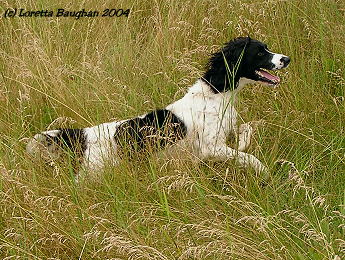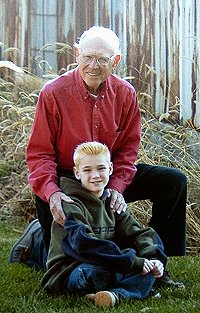 Clearly, to the field trailer or hunter, the most exciting action in the field is the springer spaniel in hot pursuit of a running bird; the ultimate driving flush and sharp retrieve all accomplished with style and control. This is the "big play" sure to add points to the score as in any other sport.
By contrast, the dog that trails but is unsuccessful in finding the bird might be faulted by judges. A review of the Conduct and Judging of Springer Field Trials makes only this reference to moving birds: "if a dog trails a strong-running bird to the right or left, it is up to the judge to decide how far off course a dog should be permitted to work. If a bird be followed off course for a long distance even though a flush and fall be eventually accomplished, this can unnecessarily delay the trial. Hence if the judge decides further pursuit is not necessary, the dog should not be penalized if he has failed to flush the bird, provided he has exhibited drive and nose and he should be given credit for being under control when ordered to leave the line."
Other than to terminate the pursuit to avoid delaying the trial, this guideline to paragraph six of the Standard Procedures for Spaniel Field Trial fails to address other aspects involved in pursuit of the runners. The judge then must rely on his personal opinions.
It should be understood that this presentation is not to question past or present judging decisions. Rather it is an attempt to broaden the dimensions of the standard by posing questions and propositions.
Is the dog who leaves his course in pursuit truly "committed" - a popular buzz word in the gallery? We have even seen handlers "pick up" their dog after an unsuccessful pursuit thinking that this constituted a serious failure, further evidence of how deeply this notion has pervaded. Is the dog that exhibits drive and nose who has otherwise has shown good bird sense, but is unsuccessful in producing a running bird to be penalized? Over the years, we have seen dogs dropped because of this, an indication that the judge considered this a fault comparable to a break or failure to retrieve.
Can only the judge make the decision to terminate the pursuit or does the handler have the leeway to make this decision? The experienced handler in training sessions and in field trials has frequently seen his dog in pursuit of a runner, then observed the change in the dog’s demeanor such as circling or to resume quartering, indicating that the trail has ended. Should not the handler who knows his dog’s tendencies - perhaps better than the judge - have the prerogative to bring his dog back to the line and proceed down course?
While some dogs have better olfactory senses (nose) than others, they all are subject to the variation of scent which is the pheasant’s body odor. When the dog smells this, it causes a sensation resulting from chemical stimulation of the olfactory receptors in the nose. The chemical substances in odors are volatile or unstable which means they are subject to environmental conditions such as temperature, wind velocity, the density of the vegetation to which the scent is deposited, barometric pressure and time elapsed before the disintegration of the odor.
Using this information, we can then understand why in some cases the pursuit of the running bird is unsuccessful.
"It continues to be my opinion that as we look for the dogs that can make the "big play", we should not mark down those dogs unsuccessful in pursuit of the moving bird without taking into account the possible disintegration of the scent."
Foremost is the possibility that the bird has flown away which ends the scent trail. Another important reason is the disintegration of scent which is more common in the moving bird and dependant on the distance between dog and bird. The disintegration is also enhanced by the velocity of the wind in direct proportion.
The ability and experience of the dog to follow scent obviously plays a part, but this can be sorted out by further observations as the dog has the opportunity to work or has worked additional birds.
Some years ago when Mark Schinderle and I judged a Nebraska trial, we deliberated about problems with moving birds in our pre-trial discussion. We were both of the opinion that a dog who did not succeed after a positive pursuit of a moving bird should not be faulted. This was contingent, of course, on the bird not being seen by the judge or that the dog did not consistently fail to produce after making game. We considered the many reasons for the unsuccessful finds taking into account facts such as the bird may have flown away, poor scenting conditions or lack of adequate ground cover to name a few.
As it turned out, we did have a number of these incomplete pursuits - some dogs of which went into the third series still in contention.
As the trial progressed, we noted that the handlers, realizing our attitude in this regard, became more inclined to go off the course with the dog to at least have a look rather than play it safe and continue to quarter the dog down the course for easy finds.
It continues to be my opinion that as we look for the dogs that can make the "big play", we should not mark down those dogs unsuccessful in pursuit of the moving bird without taking into account the possible disintegration of the scent. In addition, the dog should be given other opportunities to display its scenting ability. We should give the handler the leeway to terminate the pursuit just as he would on a day’s hunt.
A final quote from the Standard Procedure says it all: "Judging on faults rather than positive qualities can result in a set of placements that fail to possess class and hunting drive so necessary if a breed is to improve or even hold its own."

|
|
|
| Bookstore | The Bookshelf | Advertise on SJ | Classifieds | Resources | Events | NEW! Point Standings | Letters | Archives | Spaniel Journal | |

